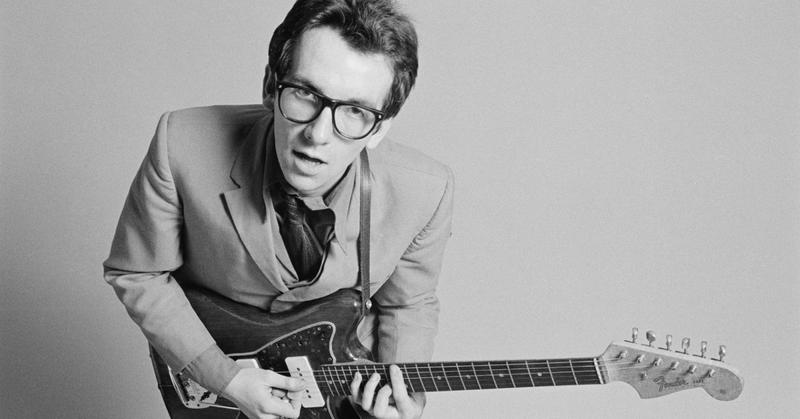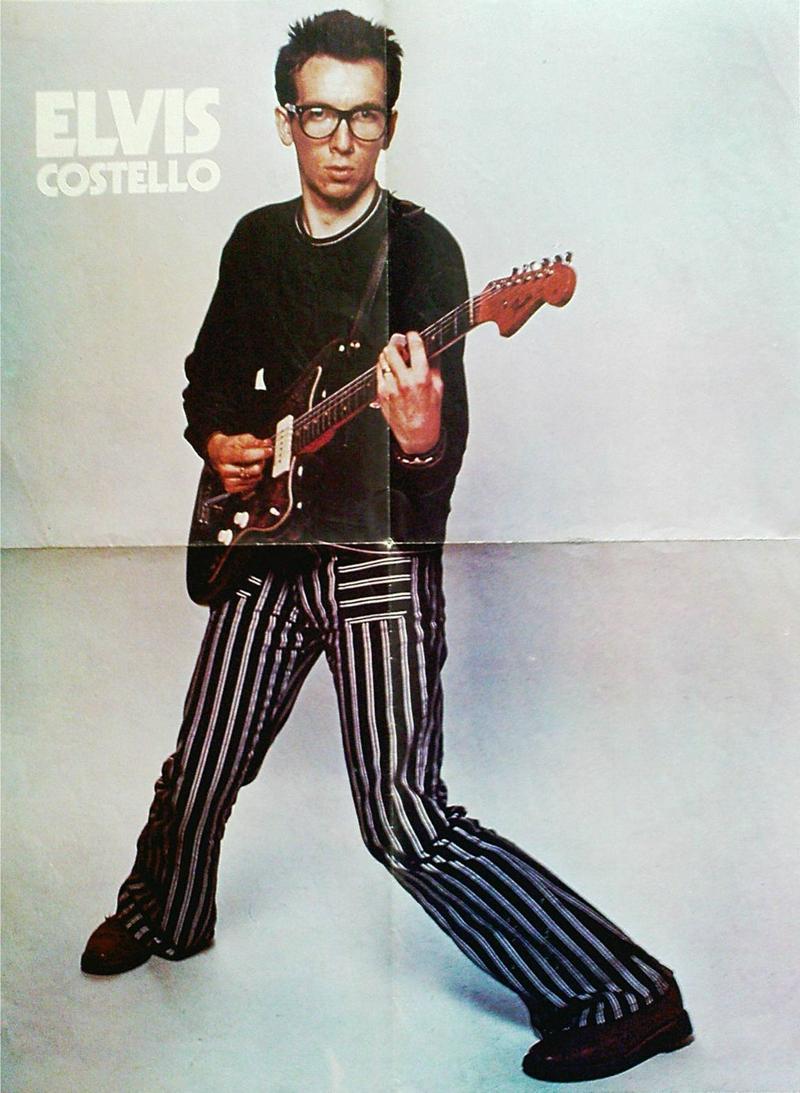'My Aim Is True:' Facts And Trivia About Elvis Costello's Debut
By | July 18, 2020

Elvis Costello's My Aim Is True is among the greatest debut albums in rock history, containing classics including "Alison," "(The Angels Wanna Wear My) Red Shoes" and "Less Than Zero." To this day, it holds up as one of Costello's best, even though it's one of those releases that probably shouldn't even exist. Though he's lumped in with the punk movement, Elvis Costello was fundamentally different: He was married, with a newborn, living in the suburbs and working a day job. Recorded with a borrowed backing band on his sick days, My Aim Is True is proof that anyone can be a rock star -- all it takes is an abundance of talent and determination.
The glasses were there, so was the Fender Jazzmaster and the attitude, but as he entered the minuscule recording studio on sick days from his day job Declan MacManus had yet to adopt the name that made him famous: Elvis Costello. 1977's My Aim Is True, a 12-song set that clocks in at just 32 minutes, is filled with songs of sexual frustration, romantic frustration, and general youthful anger. By combining punk, vintage rock 'n roll, and whip smart lyrics, Elvis Costello created something totally unique with this landmark album.
Costello was working a day job while recording the album

In the mid ‘70s, Costello was performing as a singer-songwriter around England with little acclaim. His life revolved around his day job working in data entry at the cosmetics company Elizabeth Arden during the day, and quietly writing songs to keep from waking his wife and newborn son at night. Money was short for the young family, and Costello writes in his autobiography that he could barely afford to buy new records, a pastime that brought him true joy:
My wages had only increased a little from my days as a lackey in the bank to my current job bluffing my way through the computer world next to a lipstick factory. I made about £30 a week, so I took any available overtime. Mary did a little part-time work, such as parenthood allowed, and we got by. About once every four or five weeks, I might save enough money to buy a record. So, if I abstained from the beer and cheese roll that often passed for my lunch, I might get to buy Blood on the Tracks or Randy Newman’s Good Old Boys.
Costello’s songs were good enough to get him noticed by Stiff Records, who offered to sign him on as a songwriter for Dave Edmunds, but not as a performer. Costello felt that the offer was better than nothing, but Edmunds balked at the idea. Rather than sending Costello on his way, Stiff asked him to re-record his demos with the members of Clover, an American country-rock band then based in the UK, as his backing band, and Nick Lowe producing.
(Huey Louis, a vocalist and member of Clover, wasn't needed for the sessions. He would later change the spelling of his name to Huey Lewis, and members of Clover would form his backing band, The News.)
He recorded the album in 24 hours

Costello was chomping at the bit to record his debut album, but he didn’t exactly have the budget to take weeks off from work to carefully hone his songs in the studio. Instead, Costello says that he took six sick days in 1976 and 1977 where he made the most of the fours hours of studio time per day that he could afford at Pathway Studios in Islington. All in all, he spent 24 hours in the studio and came out with gold. In the 1993 re-release of My Aim Is True, Costello writes:
As I still had my ‘day-job’ these sessions had to take place on ‘sick days’ and holidays during late 1976 and early 1977. The musicians were members of the Marin county band Clover, who could not be credited at the time due to contractual reasons. The producer was Nick Lowe, who I had met, unlikely as it may sound, in The Grapes public house, opposite The Cavern, Liverpool in 1972.
The truncated sessions left little time for fooling around or studio tricks, so what you hear is just Costello and his backing band banging out the songs to the best of their ability.
Bob Lefsetz, who played bass for Clover, wrote that the beauty of the album is thanks to the lack of time that they had to record. He wrote in his newsletter:
Nick [Lowe] was the perfect compliment with his no-bulls**t approach to production -- Scully 8 track with a tiny board at Islingdon studio in the east end. The studio was about as big as your bathroom and there was no booth -- strictly seat-of-the-pants.
“Alison” was written about a woman Costello saw in the supermarket

When it was released as a single in 1977, “Alison” hardly registered on the radio, but it’s gone on to become one of his most enduring songs and it’s a live staple to this today. To hear Costello tell it he dreamt up the song after seeing a woman in the supermarket and wondering what her life might be like. He writes in autobiography:
I've always told people that I wrote the song 'Alison' after seeing a beautiful checkout girl at the local supermarket. She had a face for which a ship might have once been named. Scoundrels might once have fought mist-swathed duels to defend her honor. Now she was punching in the prices on cans of beans at a cash register and looking as if all the hopes and dreams of her youth were draining away. All that were left would soon be squandered to a ruffian who told her convenient lies and trapped her still further.
Costello wrote “(The Angels Wanna Wear My) Red Shoes" in 10 minutes on a train ride

Another failed single from My Aim Is True, “(The Angels Wanna Wear My) Red Shoes" has taken on its own life in the decades since its release. Not only is it a really fun up-tempo number, but it’s super weird. The lyrics tell the story of an angel appearing to Costello to offer him immortality in exchange for his cool shoes. The odd tale came to Costello while he was taking a train to visit his mother. He told Rolling Stone:
I wrote it in 10 minutes on a train out of Liverpool — the whole song in one gulp… And then there was the whole comedic thing of getting it down. Nowadays you can demo things on your phone. I had to block it out in my mind. Then I had to get off the train, get to my mother's house, grab an old guitar I had there and play the song until I imprinted it in my memory. I had no tape recorder. I had no way other than repetition to drill it into my head so I wouldn't lose it.
The artwork is still one of the coolest LP designs ever

Even if you’ve never heard My Aim Is True, you know what the album art looks like. A black and white photo of Elvis Costello striking an awkward pose with his knees bent in and his Buddy Holly glasses. The photo is surrounded by a checkerboard design that features the phrase “ELVIS IS KING” over and over again. Designed by Barney Bubbles, a graphic artist who designed LPs for artists as varied as Hawkwind, The Damned, and Big Star, he deliberately mis-cropped the photo, offsetting the design. It’s a brilliant technique that makes you look twice (if you can manage to look away) and it works perfectly with the off kilter theme of the album.
The LP also came with a name change for the singer-songwriter. He was no longer Declan MacManus, he was now Elvis Costello. According to the songwriter the herky jerky pose on the front of the record is the only one that was usable, it just so happened to be one of the coolest photos ever taken. He explains:
I continued with my computer job after my first single came and went without troubling the charts. I'd been given a new name: ‘Elvis Costello.’ It sounded like a dare. People had weirder names than that in those days. I didn't give it another thought until August 1977. It also seemed that the squarer I looked the better the camera liked it. The cover image of this album was one of the few usable frames as the rest of the session reveals how comical the whole knock-kneed stance seemed to the photographer and subject.
The album was successful in spite of the initial singles doing little on the charts

Stiff Records released two singles from Elvis Costello in the first half of 1977, “Less Than Zero” came out in March of 1977 to little acclaim and in May “Alison” was sent to shops - neither of them made any waves with listeners. Even with those singles falling on deaf ears Stiff Records decided to send Costello out on tour, he just had to quit his job first. He wrote in the 2001 liner notes of the album’s re-release:
The single release of ‘Alison’ was also a commercial failure but it was finally agreed that My Aim Is True would be released in the summer of 1977. I was asked to quit my day job and turn professional. The ‘management company,’ Messrs. Riviera and Robinson, said they would match my less than spectacular office wages. My record advance consisted of £150, a new cassette tape recorder and a Vox battery powered practice amp. I took some of my new found wealth and bought back a copy of Hard Day's Night that I had recently been forced to sell to pay the gas bill. About three weeks later I was on the cover of a music paper — an overnight success after seven years.
My Aim Is True was a bigger hit than any of the four singles that were released from the album, and Costello was minted as a superstar.
All he needed was his own band...
